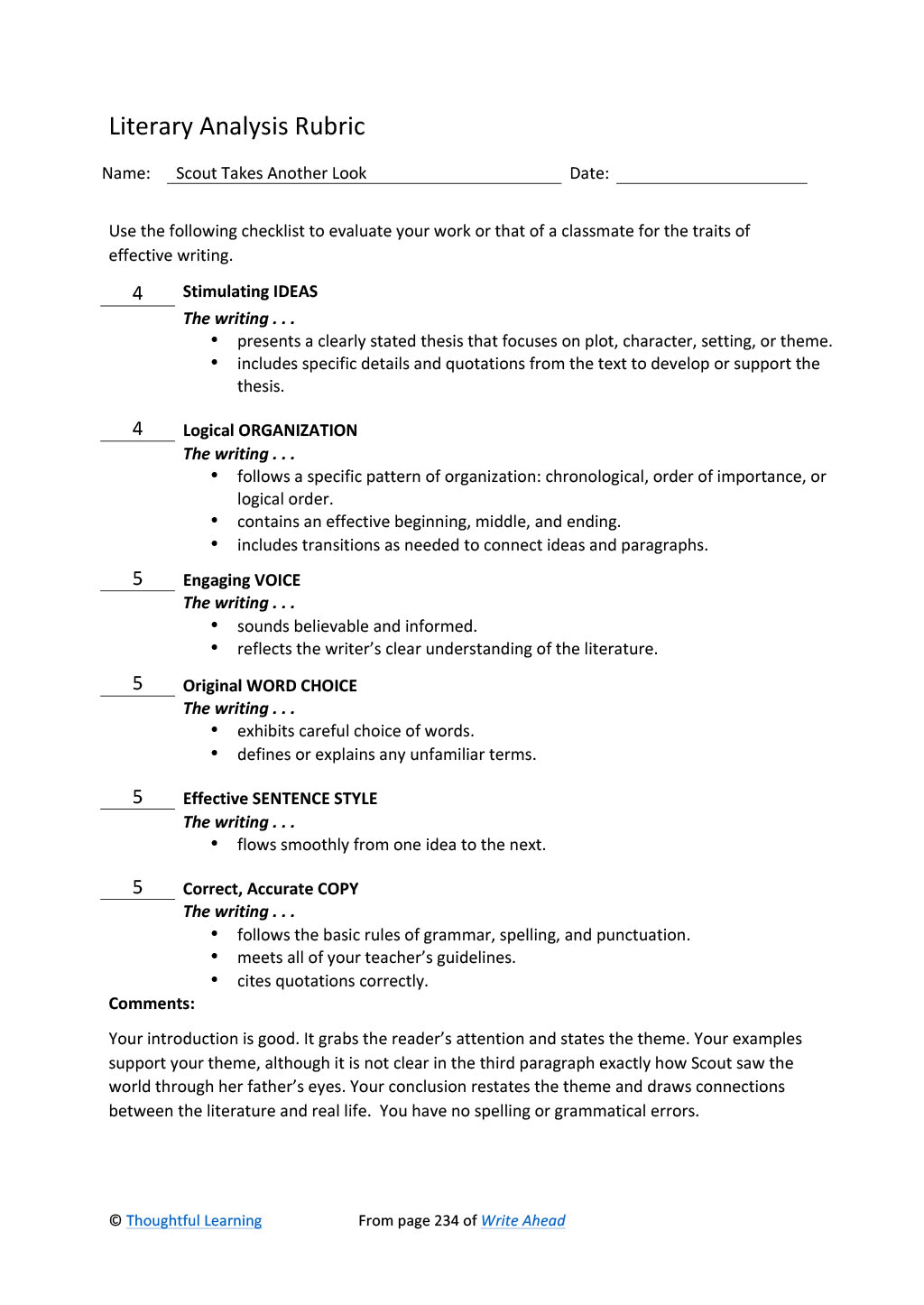Student Model
Scout Takes Another Look
You might judge the book To Kill a Mockingbird from its title. You might read the title and think that the author, Harper Lee, will tell a depressing story. To Kill a Mockingbird is anything but depressing, although the story takes place in the South during the Great Depression. It tells the story of a young girl named Scout. Over a period of two years, she discovers that her brother, her dad, and her neighbors are not who she thought they were. One theme of To Kill a Mockingbird is that deep down every person has something to offer the world and sometimes people don’t realize it until they see the world from another person’s viewpoint. Often it takes a crisis before people can see the good in another person.
Scout, who is only six when the book begins, is quick to judge. She lives in a small community where people are known by what their families are like. For example, as Scout explains to her new teacher, the Cunninghams do not like to owe people. Her explanation is supposed to explain why the boy sitting behind her will not accept lunch money from the teacher. Members of Walter’s family have always been poor, but they refuse handouts. Walter is just following his family’s way of life. Other families are different. The Ewells are mean and ignorant. The Radleys keep to themselves. The Finches seem a little strange, but they are always fair. Scout has learned to judge what a person is like based on what family he or she comes from, but something happens to change that idea.
Although Scout is devoted to her father, she does not think that he is talented or has much to offer the world. Atticus Finch is older than most of her friends’ parents. He is a lawyer, and he prefers to sit and read rather than play football. Scout does not see what her father can do until a rabid dog appears in the middle of town. In a suspenseful moment, Finch drops his glasses in the street and shoots the rabid dog with one shot. Amazed, Scout learns that her father was once known as “One-shot Finch.” He gave up guns because he thought they were dangerous. Scout is impressed and sees her father in a whole new light.
Throughout the book, Scout and her brother, Jem, tell tales about the mysterious Arthur Radley. He is a neighbor they nicknamed Boo because he has not been outside his house in many years. The two children think that Boo Radley must be crazy, and they listen to rumors that Boo is also dangerous and mean. They spend a whole summer trying to think of ways to get Boo to come out of the house. Scout does not meet Boo Radley until the end of the novel when he saves her and her brother’s lives. When she finally meets him, she discovers that he is extremely shy. He is childlike in his appearance, and he hides in the shadows. Despite the fact that Boo saved Scout’s life, he is afraid to walk across the street by himself, so Scout walks him home. She stands on his porch and imagines what his life has been like. She feels she understands this stranger who is now a friend.
Atticus Finch’s earliest lesson to Scout is simple: “You never really understand a person until you consider things from his point of view . . . until you climb into his skin and walk around in it.” Throughout the novel, Scout is learning to see the good in people, even in people she is afraid of or dislikes, by seeing the world from their points of view. She learns that the Cunninghams are not only poor but nice. She realizes her father is not only smart but brave. She discovers that Boo Radley is not crazy but shy. The theme of walking in another person’s footsteps sounds simple. However, it’s often challenging because it forces people to really think about how they judge others. The world today is still a place filled with conflict, and people could all benefit from thinking about other people’s viewpoints before making judgments.

Rubric


Scout Takes Another Look by Thoughtful Learning is licensed under a Creative Commons Attribution-NonCommercial-ShareAlike 4.0 International License.
Based on a work at k12.thoughtfullearning.com/assessmentmodels/scout-takes-another-look.